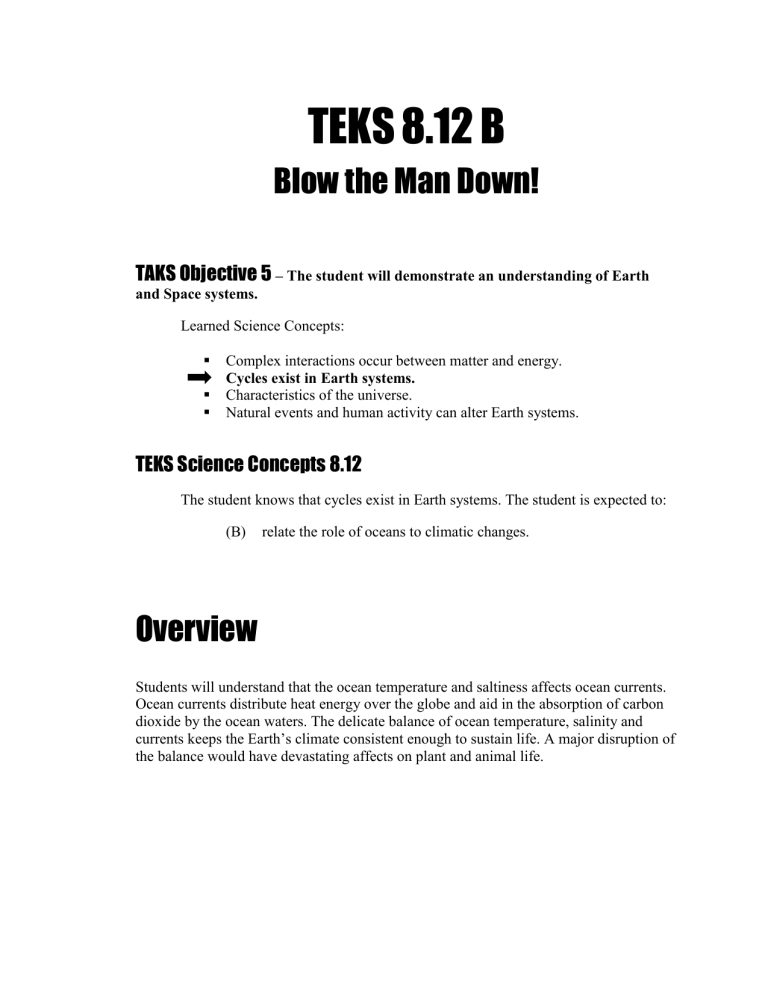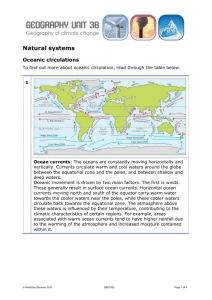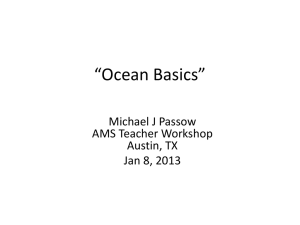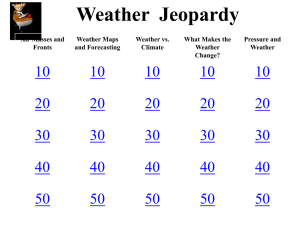TEKS 8.12 B - Blow the Man Down

TEKS 8.12
B
Blow the Man Down!
TAKS Objective 5
– The student will demonstrate an understanding of Earth and Space systems.
Learned Science Concepts:
Complex interactions occur between matter and energy.
Cycles exist in Earth systems.
Characteristics of the universe.
Natural events and human activity can alter Earth systems.
TEKS Science Concepts 8.12
The student knows that cycles exist in Earth systems. The student is expected to:
(B) relate the role of oceans to climatic changes.
Overview
Students will understand that the ocean temperature and saltiness affects ocean currents.
Ocean currents distribute heat energy over the globe and aid in the absorption of carbon dioxide by the ocean waters. The delicate balance of ocean temperature, salinity and currents keeps the Earth’s climate consistent enough to sustain life. A major disruption of the balance would have devastating affects on plant and animal life.
Instructional Strategies
Students will discover relationships between water temperature, salinity, gas absorption and currents through hands-on activities where they can manipulate the variables.
Students will role play the parts of policy makers and use science facts and predictions to make decisions.
Objectives
1.
Students will be able to describe how water temperature and salinity affect ocean currents.
2.
Students will be able to explain the effect of temperature and salinity on solubility of gases in ocean water.
3.
Students will be able to relate past and present climate to the ocean.
4.
Students will use scientific arguments to predict how changes in ocean water temperature and salinity will affect future world climate.
For Teacher’s Eyes Only
Ocean Circulation
Oceans cover about 71% of the Earth’s surface. They play a much larger role than just providing the Earth with water. The oceans have different names, but they all connect to form one big body of water. The composition, temperature and circulation of the ocean’s water play major roles in controlling the Earth’s climate.
Seawater is a complex, active fluid. It is composed of both organic and inorganic materials including: pure water, dissolved gases, salts and microscopic living organisms.
As the ocean waters circulate over the globe, these components distribute and contribute to the maintenance of living systems.
Ocean water circulation is caused by two factors: wind and water density. Differentiated heating of land and water along with latitude heat differences, create wind patterns across the surface of the planet. These winds cause surface currents that circulate the ocean water. Water density is a combined result of water temperature and water salinity and causes thermohaline circulation. The volume of this deep undersea current is 16 times greater than the flow of all the Earth’s rivers combined. The continuous deep-sea circulation oxygenates the deep oceans and redistributes heat from the equator to the poles.
Ocean temperature and salinity
Ocean currents transport heat around the globe like a giant conveyer belt. Warm waters from the Gulf of Mexico flow north heating the air. The waters get cooler, saltier, and denser until near Iceland the waters sink and begin traveling southward along the ocean floor. As the water moves south it begins to warm until eventually it is warm enough to rise and the cycle continues.
In the Indian Ocean, the water is too warm to sink. Even though the water is cold in the
Northern Pacific, it is not salty enough to sink. It is believed that snow and rains in that part of the country run into the ocean and reduces saltiness. Water temperature is extremely important but not just because of density. Warm water cannot hold as many dissolved gases as colder water. If water warms to the point where the concentration of such dissolved gases as oxygen and carbon dioxide are greatly reduced, there would be a huge impact on plant and animal life.
Carbon dioxide
Carbon dioxide easily dissolves in water. This reaction acts to reduce the amount of carbon dioxide in the atmosphere and supplies gases to the ocean plants. Reduction of atmospheric carbon dioxide helps to control the greenhouse effect and thus the warming of the Earth. Less salty seawater also holds higher concentrations of carbon dioxide.
There is a delicate balance to maintaining the oceans. If the carbon dioxide levels in the atmosphere increase (as they are at a rapid rate) due to the burning of fossil fuels among other things, the temperature of the planet will increase. Polar icecaps and glaciers will begin melting and reduce the salt concentrations of the cold water in the north. If the water is not dense enough to sink and flow south, then the circulation of water that both increases the absorption of carbon dioxide and helps to distribute heat will not occur.
Reduction of absorption of carbon dioxide will result in increased greenhouse effect and the planet will become even warmer.
Though climate changes are usually slow, the rise in Earth’s temperature as a result of global warming appears to be significant in the last forty years. Scientists do not agree on what will happen to the climate and the future of the planet. It is unclear whether the ocean will act as a catalyst to speed up the effects or as a control to slow down the catastrophic results.
Ocean Currents
5 E’s
Engage
Activity: Engaging the senses
Class Time: 10 minutes
Materials:
A bottle containing fresh cool water
A bottle containing water that has been boiled and cooled
A bottle containing carbonated water (Club soda)
Paper cups for each student
Preparation:
Not all water is alike. Let students discover water’s ability to dissolve and hold gases through using their sense of taste. The night before this activity, obtain three bottles of water and label them A, B and C or some other nondescript title. One of the bottles should contain carbon dioxide and is commonly known as Club Soda. (Tonic water, Seltzer water, and Perrier contain other things that change taste and should not be used.) Boil the water in one of the bottles and when cooled, return the water to the bottle without agitating the water and leaving as little airspace as possible. Students should label their cups A, B and C to match the bottles. The water can be served room temperature but be careful opening the club soda as to not loose the carbonation.
Procedure: With no explanation, allow students to taste the water from each of the three bottles.
Explore
Exploration 1
Activity: How does temperature and saltiness of water cause ocean currents?
Class Time: 1 class period
Objective: Students will be able to describe how water temperature and salinity affect ocean currents.
Process Skills:
TEKS 8.2 (B) Students will collect data by observing and measuring.
Materials:
Clear glass or plastic cup
Large Styrofoam cup that will partially fit into clear glass
Salt
Beaker
Water
Hotplate
Ice
Food coloring
Index card
Stopwatch
Digital camera (optional)
Caution hotplate gets hot!
Classroom Management: This activity can be executed in several different ways depending upon classroom management preferences. It can be done as a whole-class demonstration, as teacher prepared materials for small group or as small group preparation.
Pre-activities: The activity will allow students to test multiple possibilities and determine cause and effect related to water temperature and water saltiness in the ocean.
Before doing this activity, students should discuss the different combinations that can be tested. In order for each group to be able to compare results with other groups, some experimental controls must be put into place. Examples of these controls are cold water temperature (maybe 5 degrees Celsius), warm water temperature (maybe 35 degrees
Celsius), salt concentration (same amount of salt added to each 10 ml water) and how data are collected (drawings, photograph, time with a stopwatch, etc.)
Procedure:
Groups may test a variety of combinations of their choice. A few examples are:
Warm water on top – Cold water on bottom
Cold water on top – Warm water on bottom
Salty cold water on top – Pure warm water on bottom
Salty warm water on top – Pure warm water on bottom
1.
Each group will select the variables for the experiment. Put the liquid selected for the bottom into the clear cup. Fill the cup so that the Styrofoam cup bottom will extend into the contents.
2.
Cut a 2 cm. hole in the bottom of the Styrofoam cup and place a piece of paper over the hole.
3.
Carefully fill the Styrofoam cup with the second liquid. The contents should be dyed with food coloring so resulting currents, if any, will be visible.
4.
Remove the paper in the bottom of the Styrofoam cup without disturbing the liquid.
5.
Record the results.
Exploration 2
Activity:
You’ve got gas.
Objective: Students will be able to explain the effect of temperature and salinity on solubility of gases in ocean water.
Materials:
Carbonated water (chilled)
Carbonated water (room temperature)
Tap water (room temperature)
Salt
Plastic spoons
Plastic cups
Compare results with pure water and room temperature and cold Club soda (carbonated water). Half fill the cups with the different waters. Add a little salt to each and record results. Make sure the quantities of waters are the same and the same amount of salt is added to each. Add more salt. Continue to add salt to each until nothing more happens.
What conclusions can be drawn? Share results as a class.
Explain
Results of the activities show that cold salty water sinks and warm unsalted water rises.
The rates that the rising/sinking occurs are important to ocean currents. The saltier the water the faster it sinks. The warmer the water, the faster it rises. Cold water can dissolve more carbon dioxide than warmer water. Salt decreases the solubility of carbon dioxide in water. It is important that the students understand all of the things which affect the distribution of heat energy over the surface of the Earth.
Show a diagram of prevailing winds and discuss how this winds blow across the surface of the oceans and cause waters to move in circulating patterns over the globe. The ocean temperature is warmer in the equatorial regions. As the warm waters are carried north, the water warms the cooler waters of the north. As the water is carried further north, it is cooled and these cooler waters are then circulated as they are carried south where they are again warmed.
Show the NOVA production titled What’s up with the weather?
Elaborate
Elaboration 1
Research: Climate through the ages.
Class Time: 1 class period
Objective: Students will be able to relate past and present climate to the ocean.
Process Skills:
TEKS 8.3 (A) – The student is expected to analyze, review and critique scientific explanations, including hypotheses and theories, as to their strengths and weaknesses using scientific evidence and information.
Students investigate climate conditions and changes that have occurred over the centuries. Use all resources available. Determine the role the oceans played.
Elaboration 2
Research: Climate conditions across the globe.
Class Time: 1 class period
Objective: Students will be able to relate past and present climate to the ocean.
Process Skills:
TEKS 8.2 (C) – The student is expected to organize, analyze, evaluate, make inferences and predict trends from direct and indirect evidence.
As a small group or individual projects, have students choose a country or part of the world. Research weather and climate conditions in the area. Find out about the ocean in that part of the world, such things as water temperature, plant and animal habitation, ocean currents, etc. Have students predict how global warming could change the ocean in their selected part of the world and what would be the resulting climate changes.
Elaboration 3
Role play: Is global warming threatening?
Class Time: 2 class periods
Objective: Students will use scientific arguments to predict how changes in ocean water temperature and salinity will affect future world climate.
Process Skills:
TEKS 8.3 (D) – The student is expected to evaluate the impact of research on scientific thought, society and the environment.
Hold a mock congressional committee meeting on global warming. Students can represent various corporations such as power companies or automobile manufacturers, environmental protection agencies, scientists, etc. Students should research and collect information supporting their arguments. Each person or persons representing on of the agencies has an opportunity to present their views to the congressional committee. The committee should then make decisions and write a supporting document clarifying their decision.
Evaluate
Evaluation 1
Ask students to draw a pictorial representation of the oceans and how they affect global climate. The students can emphasize any aspect they want such as prevailing winds and land temperature, alinity and current flow or global warming and water temperature. Let the students be creative and be flexible. Papers should be graded on the correctness of the content, completeness of the cycle illustrated and clarity of the diagram.
Evaluation 2
Ask students to argue the point: maintaining the present conditions of the oceans is important to the survival of the world. Have students choose a scenario where one factor is drastically changed. S








